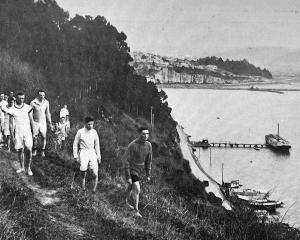The Dunedin, after leaving for the south, found that her wireless equipment was not working satisfactorily, and in accordance with arrangements, called in at Bluff to have it seen to, the fact of the big wireless station being at Awarua making it possible to receive more adequate attention than was the case here.
The tug left Bluff at 3.40 p.m. on Saturday and announced her arrival alongside the Aurora at 3.30 a.m. yesterday, in latitude 49.17deg., longitude 168.32deg. east, distance from Otago Heads 140 miles.
This is much shorter than what was expected to be the case, and the result is that the Aurora will get here a good deal sooner than could have been predicted when it was known that the Dunedin was forced to call in at Bluff.
The position of the vessels has been wirelessed constantly since the tug commenced to give its assistance.
A heavy sea was then running, but good progress was being made.
The Aurora lost her anchors in the south, but whether she will come inside the Heads to-day, or whether, as was the case when the Discovery returned from the Polar regions, she will remain outside till her copyright story has been safely delivered and published in London and New York, cannot be told.
It is probable, however, that she will come inside, but not immediately to a berthage at Port Chalmers.
She is, of course, somewhat badly strained, and with the fact that her jury rudder has already once been carried away, one would expect that she would not willingly be kept outside.
Information on the point cannot be got from the Aurora, and no one can tell what instructions may have been issued to her commander as to the procedure to be adopted.
The tug Koputai, with members of the Otago Harbour Board on her, will leave the Dunedin wharf at 7.30 this morning, and will proceed to the Heads to meet the Aurora.
• A letter received by Mr H. G. Ell, M. P., from a resident of the North Island shows that there are many native birds in remote places there, and that they are at least holding their own against their enemies.
He mentions the pigeon, tui (plentiful), kaka, morepork, owl (plentiful), bittern, blue duck, robin (rare), blue-mottled crow, two species of cuckoos, parakeets (rare), little grebe (plentiful), black teal (plentiful); pukeko, grey duck, spoonbill duck, swamp rail, dotterel (rare), kingfisher, kiwi, weka, wren, tomtit, fantail, oyster-catcher, and fern-bird. He has seen all these species in the district in the interior of the island from which he wrote.
He saw a dozen kakas in a flock at some places, but does not think this bird is plentiful, and he has neither seen nor heard a bell-bird.
• An unusual find was made on the sea beach near the Mokau Heads the other day when a live snake was secured among some driftwood.
The reptile was put in a bucket of water, and next morning it was dead.
It measured 2ft 4in.
A smaller snake was seen amongst the driftwood, but was not captured.
The snake was almost black on the back and light underneath the skin, in the words of the correspondent of the Taranaki Daily News, "resembling the wrong side of a very finely woven carpet''.
How the snakes found their way to the Mokau beach is a problem. - ODT, 3.4.1916.
• COPIES OF PICTURE AVAILABLE FROM ODT FRONT OFFICE, LOWER STUART ST, OR WWW.OTAGOIMAGES.CO.NZ












